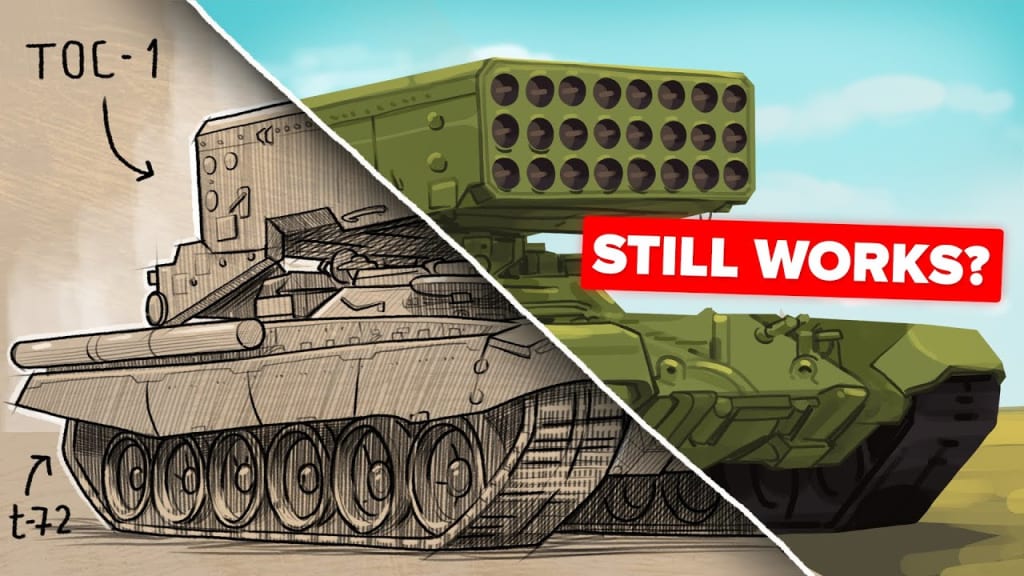What Unusual Weapons Are in Use in Ukraine?
With large numbers of men on both sides, Russia and Ukraine are arming their forces with a wide range of weaponry. While we've covered World War II-era weaponry in Ukraine extensively in previous episodes, there's more than just vintage hardware making an appearance on the battlefield today. Let's look at some of the strange weaponry being utilized in Ukraine. 🤯⛓🧲🤯

With large numbers of men on both sides, Russia and Ukraine are arming their forces with a wide range of weaponry. While we've covered World War II-era weaponry in Ukraine extensively in previous episodes, there's more than just vintage hardware making an appearance on the battlefield today. Let's look at some of the strange weaponry being utilized in Ukraine. 🤯⛓🧲🤯
Both Russia and Ukraine are using a wide range of weapons to arm their troops due to the large numbers of people on both sides. While we have covered World War Two-era weapons in Ukraine in great detail in our other stories, there is more than just retro equipment showing up on the battlefield right now. Let's look at some of the unusual weapons used in Ukraine. The RPG-30 is number one. While many people might not think an RPG is all that strange—after all, bad guys seem to favor it in every video game and movie—you would be wrong. The RPG-30 also referred to as the Kyruk or Hook in Russian, is the most recent iteration of a cousin weapon that entered service decades earlier. The RPG-30's capacity to bypass active protection systems on tanks is what distinguishes it from other weapons.
In order to shoot down incoming ordnance against a tank, an advanced armor system known as an "active protection system" (APS) uses a combination of radars, fire control computers, and mini-rockets. One of the most recent advances in armor technology is called APS, and nations have been searching for effective strategies to counter it for years. The RPG-30 provided the Russian government with the answer it was looking for in 2008. The decoy rocket is launched from a side tube below the main 105mm rocket and fires just a fraction of a second before the main rocket. Operators can then throw away the tube after it has fired. The aim of the system is to get the tank to waste a rocket on the dummy so that the main rocket can hit the tank because it is fired just a tiny bit faster.
The tank will wait a split second before re-engaging because it believes the threat is gone. The nearly 23-pound grenade only needs that slight lag time before slamming into its target. Up to 650mm of sloped armor is said to be destroyable by the RPG-30. It is true that these have been used on the battlefield, even though this claim has not yet been verified. Fortunately for Ukrainian troops, there are systems like the Israeli-designed Trench Coat system that can neutralize such weapons by launching a number of additional missiles each time the APS detects a threat. The presence of such a system on Ukrainian tanks is unknown, though. Number Two RPO-A Shmel Developed at the very end of the Cold War, the Shmel was intended to be a man-portable fire support system that could deliver massive firepower in circumstances where artillery or air support was inaccessible or impractical to use.
The Shmel rocket system, which weighed slightly more than 22 pounds, was reusable and offered the user a variety of warhead options. There was a thermobaric warhead as the main weapon. In contrast to conventional high explosives, thermobaric weapons are much more lethal in urban settings. The damage that thermobaric weapons or vacuum bombs inflict is caused by sucking up all the available oxygen in the area, as opposed to the normal high-explosive damage. Even those who are hidden behind cover, in structures, bunkers, or trenches can suffer catastrophic damage from the ensuing explosion and pressure change. It's a kind of wonder weapon for an infantry squad because it can kill people who an operator cannot see.
However, it can fire a variety of ammunition in addition to thermobaric weapons. The Shmel is capable of firing both smoke and incendiary rounds. The 20 pellets that are inside these warheads ignite as soon as the warhead emerges from the tube. The flames can burn at an impressive 800 to 1000 degrees Celsius for five to seven minutes on their own before striking a target using a substance called Pyrogel. When they released a lighter version of the Shmel in 2003 with improved thermobaric munitions, the Russians even strengthened the Shmel. Three M14 rifles other surplus rifles from the Cold War are also being used on the front lines in Ukraine, in addition to surplus World War Two weapons. In 1959, the M14 became the standard battle rifle for the US military.
However, its bulky size, intimidating full auto fire, and heavy weight did not endear it to the troops in Vietnam. As a result, the US military began converting its entire force to the M-16 six years after it was first put into use. By the end of the war, snipers and other designated marksmen were the main users of these battle rifles. With little use for them after Vietnam, the US had over a million of these rifles. They began to sell them off as often as they could as a result. Tens of thousands of M14 rifles were sold by the US to the Baltic nations of Latvia, Lithuania, and Estonia when they joined NATO between 1991 and 2004. The Baltic nations, like their American counterparts, relegated these rifles to a sniper role, where they saw action in Afghanistan and Iraq.
The Baltics gave Ukraine between 5,000 and 7,000 M14 rifles as part of an agreement to send those nations better sniper rifles. According to pictures and videos, Ukrainian soldiers are also employing the rifle as a sniper weapon. Number Four: The TOS-1 is the Shmel on steroids. The TOS-1 is a powerful weapon system that was initially created for use during the Soviet occupation of Afghanistan. The TOS-1 can quickly destroy any fortified structure or armored vehicle by launching two dozen 220mm rockets in a matter of seconds. The thermobaric or incendiary warheads of the weapon system increase its already impressive firepower. As a result, some contend that the TOS-1 is the most powerful non-nuclear weapon Russia is capable of using in combat.
A T-72 tank's chassis powers this monstrosity. Due to the limited range of the rockets, the Soviets made this decision. The effective range of the first models was only three kilometers, and upgrades to the munitions over the years have only increased this to ten kilometers. Additionally, the number of these in Russian service is extremely low. The Russian military only has a small number of these remaining in its stock despite exporting dozens of them to Iraq, Syria, and Azerbaijan, where they were used in combat. These saw heavy use in the battles for Kharkiv and in the Donbas, where they numbered around 16 units before the war began.






Comments
There are no comments for this story
Be the first to respond and start the conversation.